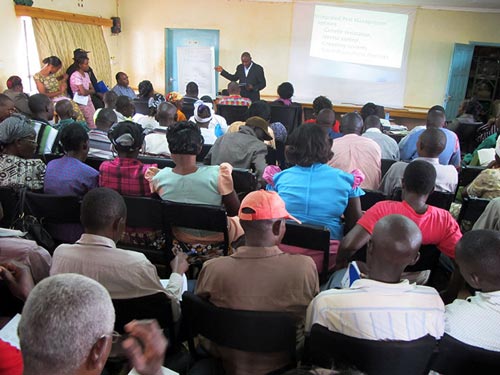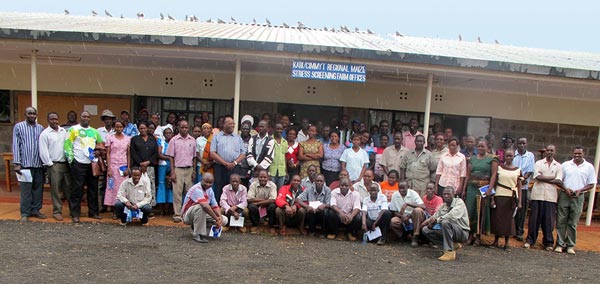By Wandera Ojanji /CIMMYT

The farming community around the Kiboko Crops Research Station in Makueni County, Kenya, has agreed to stop growing maize for two months to help curb the spread of maize lethal necrosis (MLN) disease. The decision impacts farmers who depend on maize as a staple crop and cash crop and is also a sacrifice for scientists from CIMMYT and the Kenya Agricultural Research Institute (KARI).
Stakeholders made the decision on 1 October during a meeting at the station to help determine how to manage the disease in the area. The maize-free window will take place in March and April 2014 and is critical in interrupting the disease cycle, thus reducing the population of vectors. Stakeholders agreed to plant maize by 15 October and harvest it by 29 February. Attendees received information about the disease and its identification and planned for its management in the area. The meeting was organized by Stephen Mugo, principal scientist for the CIMMYT Global Maize Program. Mugo, a maize breeder, is also the coordinator of the Insect Resistant Maize for Africa (IRMA) and Water Efficient Maize for Africa (WEMA) projects in partnership with KARI and the Ministry of Agriculture.

More than 100 people attended, including the county administration, local community leaders, Makueni County agricultural staff, Kiboko farmers and CIMMYT and KARI scientists. George Mahuku, CIMMYT maize pathologist, explained to participants the combination of factors that are necessary for MLN disease development: the presence of viruses that cause the disease such as maize chlorotic mottle virus and several cereal viruses which individually or in combination infect the maize; the presence of aphids, thrips or other insects that transmit the viruses; the use of maize varieties that are susceptible; and a conducive environment for vectors and disease.
Mahuku also explained the tell-tale signs of MLN disease, which include chlorosis, or the mottling of the leaves; premature drying of cobs; stunting and/or cobs with uneven spots; tip dieback resulting in no pollen production; and a poor seed set and shriveled ears. Some farmers in the area mentioned having plants with similar symptoms on their farms.
Responding to inquiries about the origin of the disease, KARI pathologist Anne Wangai said the disease was first reported in Bomet County, Kenya, where farmers have since named it Koroito, or “the plague.” It rapidly spread to neighboring counties. “In all these areas, it was a sudden phenomenon that could not be explained, whose cause was unknown, but one that was having a devastating effect on maize productivity with losses ranging from 30 to 100 percent under severe infestation,” Wangai said. To prevent the plague from hitting Kiboko, Wangai told participants to follow advice from the Ministry of Agriculture, CIMMYT and KARI. Prevention techniques include using crop rotation to break the disease cycle, not planting new maize crop near an infected field and maintaining fields clean of weeds, particularly grasses, to eliminate alternate hosts of potential vectors. Mugo said using chemicals for prevention is too expensive for small-scale farmers.
In his closing remarks, Michael Kitenje, agriculture and livestock extension officer for the Makueni District, called for unity and willingness from the farmers and other stakeholders to adhere to the window. “If we have the will, we will conquer the disease. Without the will, we are doomed,” Kitenje said, urging attendees to spread the message to those who did not attend. “In case you meet resistance, use your persuasive skills to convince those that might not easily comprehend the problem and make them understand the need for a community approach to controlling MLN in Kiboko.”
 Nutrition, health and food security
Nutrition, health and food security 
